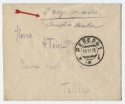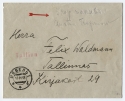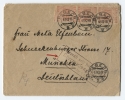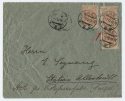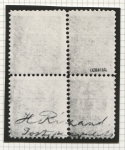One hundred years ago today, 24 November 1918, the first Estonian postage stamp was issued. To mark the centenary, we’re chronicling some of the most fascinating moments in Estonian postal history.
The postal service was important for the state and many decisions affecting the system were taken at the state level, by the Constituent Assembly that preceded Parliament, and later on the orders of the Minister of Roads. Notices pertaining to the postal service were published in the State Gazette.
Although the Republic of Estonia was proclaimed on 24 February, the country’s first stamps were issued only eight months later. For several months, independence was interrupted by a German occupation.
In spring 1918, the printing plant of Bernhard Mäns received a rush order from German officials – two fiscal stamps had to be prepared. There was no time to look for an engraver, and so the design and the template were prepared by the printing plant director, Rudolf Zero. Several thousand of the olive green tax stamps, bearing a flower design, were printed. On 18 November, the same thing happened as in the spring. This time, the postmaster general Hindrek Rikand and secretary Eduard Laaban came knocking at the printing plant, with an urgent proposal that the first Estonian postage stamp be printed. With again no time to find an engraver, Zero decided to use the templates of the German tax stamps printed in spring. Thus, the design of the first four Estonian postage stamps resembles that of the two German revenue stamps.
At first, the flower-design stamps were intended to be printed using plate printing, but due to time constraints, the simpler and faster technique of lithography was chosen. First of all, special impressions on a special paper were made, and then transferred to stone by chemical means; these were the dies used to print the stamps. The 5-kopeck pink, 15-kopeck blue, 35-penn brown and 70-penn green floral pattern stamps were printed at Bölau printing plant in Nõmme, at the address Raudtee tn 10.
The 5-kopeck floral pattern stamp was printed in four different runs, and the first stamps were printed on 22 November 1918. The paper was imported from Finland. The paper, initially white, smooth and thin, took on a yellow tone from the gum on the back. The stamps were imperforate, although primitive “postmaster’s” perforations exist in the case of stamps issued to the Juuru, Keila, Keina, Narva, Nuia, Nuustaku, Paide, Paldiski, Suure-Jaani, Tartu and Võhma post offices.
The lack of stamps did not bring the sending of letters by mail to a halt. The Estonian state postal service established a system where the sender had to personally come to the post office and pay cash for the letters to be dispatched. The postal official inscribed “paid” in handwriting on the letter or parcel.
The 5-kopeck “Flower Design Stamp” was printed in four different runs:
1st printing 22-28 November 1918. Print run 514,000.
2nd printing 11-17 December 1918. Print run 509,000.
3rd printing 5-6 March 1919. Print run 304,500.
4th printing 2-4 April 1919. Print run 614,500.
In total, 1,942,400 copies of Estonia’s postage stamp no. 1 were printed.
In the period from 3 December 1928 to 3 July 1919, an additional 3,599,500 of the light-blue 15-kopeck stamps, 2,047,000 of the brown 35 (penn) stamps and 503,000 of the green 70 (penn) stamps were printed.
The pink 5-kopeck floral-design stamp was used for domestic postcards. This rate was in force until 31 December – only about five weeks – due to which this stamp is quite rare in individually cancelled form. On 1 January 1919, the postcard rate rose to 15 kopecks, while printed matter weighing 15 grams or less could be sent for a few more months at the 5-kopeck rate.
Johann Kalmus, postmaster general of Vändra in 1918, writes in his memoirs:
“I remember clearly a December evening where I found in my mail a thick letter from the Postal Administration. I opened the latter to find the first shipment of Estonian postage stamps, 5-kopeck pink ones and 15-kopeck blue ones. The first Estonian postage stamps were now in existence! All postal employees had a high level of interest in this new feature and they had to start selling the stamps right away, as everyone wanted to take the country’s postage stamps home to show their family.“
This virtual exhibition was put together using the National Museum’s postal history collection and materials from the National Archives and private collections. The exhibition was produced in cooperation with the International Estonian Philatelic Society.
We hope you enjoy the exhibition.
Click the information button on the toolbar to find background information on postal history and general history.
Exhibition team
Team leader: Eve Aab
Consultant: Ants Linnard, chairman of the Friends of the Postal Museum
Photography: Arp Karm
Editor: Tuuli Kaalep
Literature used
Hurt Vambola, Ojaste Elmar. Handbook of Estonian philately and postal history, catalogue. Göteborgs Grafiska Grupp AB, Gothenburg 1986
Eesti Filatelist, issue no. 4, New York 1958
Eesti Filatelist, issue no. 3, New York 1957
Küng Enn, Küng Aive, Türk Toomas. Eesti rahvuslik postiteenistus 90 (90th anniversary of the Estonian national postal service), AS Eesti Post Postal Museum, Tartu 2008
Pekka Erelt. Eesti Posti lillemustriline esiklaps. (Eesti Post’s floral-patterned firstborn) Eesti Ekspress weekly, 13 November 1998
Ojaste Elmar. Eesti postmark nr. 1, mis asetas Eesti Euroopa kaardile. (Estonia’s first postage stamp, which placed the country on the map of Europe) Postisarv issue no. 5, 1998
The postal service was important for the state and many decisions affecting the system were taken at the state level, by the Constituent Assembly that preceded Parliament, and later on the orders of the Minister of Roads. Notices pertaining to the postal service were published in the State Gazette.
Although the Republic of Estonia was proclaimed on 24 February, the country’s first stamps were issued only eight months later. For several months, independence was interrupted by a German occupation.
In spring 1918, the printing plant of Bernhard Mäns received a rush order from German officials – two fiscal stamps had to be prepared. There was no time to look for an engraver, and so the design and the template were prepared by the printing plant director, Rudolf Zero. Several thousand of the olive green tax stamps, bearing a flower design, were printed. On 18 November, the same thing happened as in the spring. This time, the postmaster general Hindrek Rikand and secretary Eduard Laaban came knocking at the printing plant, with an urgent proposal that the first Estonian postage stamp be printed. With again no time to find an engraver, Zero decided to use the templates of the German tax stamps printed in spring. Thus, the design of the first four Estonian postage stamps resembles that of the two German revenue stamps.
At first, the flower-design stamps were intended to be printed using plate printing, but due to time constraints, the simpler and faster technique of lithography was chosen. First of all, special impressions on a special paper were made, and then transferred to stone by chemical means; these were the dies used to print the stamps. The 5-kopeck pink, 15-kopeck blue, 35-penn brown and 70-penn green floral pattern stamps were printed at Bölau printing plant in Nõmme, at the address Raudtee tn 10.
The 5-kopeck floral pattern stamp was printed in four different runs, and the first stamps were printed on 22 November 1918. The paper was imported from Finland. The paper, initially white, smooth and thin, took on a yellow tone from the gum on the back. The stamps were imperforate, although primitive “postmaster’s” perforations exist in the case of stamps issued to the Juuru, Keila, Keina, Narva, Nuia, Nuustaku, Paide, Paldiski, Suure-Jaani, Tartu and Võhma post offices.
The lack of stamps did not bring the sending of letters by mail to a halt. The Estonian state postal service established a system where the sender had to personally come to the post office and pay cash for the letters to be dispatched. The postal official inscribed “paid” in handwriting on the letter or parcel.
The 5-kopeck “Flower Design Stamp” was printed in four different runs:
1st printing 22-28 November 1918. Print run 514,000.
2nd printing 11-17 December 1918. Print run 509,000.
3rd printing 5-6 March 1919. Print run 304,500.
4th printing 2-4 April 1919. Print run 614,500.
In total, 1,942,400 copies of Estonia’s postage stamp no. 1 were printed.
In the period from 3 December 1928 to 3 July 1919, an additional 3,599,500 of the light-blue 15-kopeck stamps, 2,047,000 of the brown 35 (penn) stamps and 503,000 of the green 70 (penn) stamps were printed.
The pink 5-kopeck floral-design stamp was used for domestic postcards. This rate was in force until 31 December – only about five weeks – due to which this stamp is quite rare in individually cancelled form. On 1 January 1919, the postcard rate rose to 15 kopecks, while printed matter weighing 15 grams or less could be sent for a few more months at the 5-kopeck rate.
Johann Kalmus, postmaster general of Vändra in 1918, writes in his memoirs:
“I remember clearly a December evening where I found in my mail a thick letter from the Postal Administration. I opened the latter to find the first shipment of Estonian postage stamps, 5-kopeck pink ones and 15-kopeck blue ones. The first Estonian postage stamps were now in existence! All postal employees had a high level of interest in this new feature and they had to start selling the stamps right away, as everyone wanted to take the country’s postage stamps home to show their family.“
This virtual exhibition was put together using the National Museum’s postal history collection and materials from the National Archives and private collections. The exhibition was produced in cooperation with the International Estonian Philatelic Society.
We hope you enjoy the exhibition.
Click the information button on the toolbar to find background information on postal history and general history.
Exhibition team
Team leader: Eve Aab
Consultant: Ants Linnard, chairman of the Friends of the Postal Museum
Photography: Arp Karm
Editor: Tuuli Kaalep
Literature used
Hurt Vambola, Ojaste Elmar. Handbook of Estonian philately and postal history, catalogue. Göteborgs Grafiska Grupp AB, Gothenburg 1986
Eesti Filatelist, issue no. 4, New York 1958
Eesti Filatelist, issue no. 3, New York 1957
Küng Enn, Küng Aive, Türk Toomas. Eesti rahvuslik postiteenistus 90 (90th anniversary of the Estonian national postal service), AS Eesti Post Postal Museum, Tartu 2008
Pekka Erelt. Eesti Posti lillemustriline esiklaps. (Eesti Post’s floral-patterned firstborn) Eesti Ekspress weekly, 13 November 1998
Ojaste Elmar. Eesti postmark nr. 1, mis asetas Eesti Euroopa kaardile. (Estonia’s first postage stamp, which placed the country on the map of Europe) Postisarv issue no. 5, 1998

The Estonian Postal Administration was established on 13 November 1918. Hindrek Rikand was appointed as its top official. The process of taking over assets began on 15 November, and Eesti Post – the postal service - was established on 17 November 1918. At the same time, the first cancellation, the "Tallinn", was introduced. The cancellation was in use from November 1918 to May 1919. The first postage stamps in Estonia were printed on 22-28 November 1918. Until the stamps were issued, postage was paid directly in cash, and a handwritten note – “paid“, accompanied by date and signature – was inscribed on letters.
Local registered letter dated 17 November 1918, with marking Tallinn (Reval). Postage was 20 kopecks paid-in-cash. The temporary marking was in use in November and December 1918. This is one of the first items sent by post in the Republic of Estonia. A local registered letter is rare, and only one copy is known. The rate for a local registered letter was 20 kopecks from 15 November 1918 to 1 January 1919.
(Private collection)
Local registered letter dated 17 November 1918, with marking Tallinn (Reval). Postage was 20 kopecks paid-in-cash. The temporary marking was in use in November and December 1918. This is one of the first items sent by post in the Republic of Estonia. A local registered letter is rare, and only one copy is known. The rate for a local registered letter was 20 kopecks from 15 November 1918 to 1 January 1919.
(Private collection)
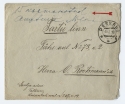
Domestic letter mailed from Tallinn to Tartu on 19 December 1918. The rate for a domestic letter was 15 kopecks, valid from 15 November 1918 until 1 January 1919. Until the first stamps were issued, postage was paid directly in cash, and a handwritten note – “paid“, accompanied by date and signature – was inscribed on letters.
(Private collection)
(Private collection)

In spring 1918, while Estonia was under German occupation, 25-penn fiscal stamps were printed by the Bernhard Mänsi printing house for the Main Department of Commerce and Industry (Hauptstelle für Handel und Gewerbe, Reval) and the Raw Materials and Trade Department (Roha, Rohstoff- und Handelsabteilung, Reval). These floral designs were later used to print the country’s first postage stamps.
(Private collection)
(Private collection)

Postcard sent to the Estonian National Museum on the date of issue of the first Estonian postage stamp, 24 November 1918. The postcard was sent by Hindrek Rikand, the temporary director of the postal, telegraph and telephone administration. The Tallinn department of the Estonian National Museum evolved into the Estonian Museum of Tallinn, later into the Art Museum of Estonia.
(National Archives)
(National Archives)

On 23 April 1919, the Constituent Assembly convened at the Estonia Theatre, and the first temporary post office, “Tallinn – Constituent Assembly” was opened. It operated only during the Constituent Assembly years from 1919 and 1920 and provided service to its delegates. It was deemed important that the body be well-connected to communications networks, and the post office was naturally provided with its own cancellation.
Letter dated 23 April 1919 from the opening day of the Estonian Constituent Assembly, with a temporary postal Office cancelation. The letter was sent to postmaster general Hendrik Rikand. The rate for a local letter was 15 penni. A first-day cancellation is rare.
(Estonian National Museum)
Letter dated 23 April 1919 from the opening day of the Estonian Constituent Assembly, with a temporary postal Office cancelation. The letter was sent to postmaster general Hendrik Rikand. The rate for a local letter was 15 penni. A first-day cancellation is rare.
(Estonian National Museum)

Registered letter to the minister of war of the Republic of Estonia, Konstantin Päts. In the period from 12 November 1918 to 8 May 1919, he was the prime minister of the Republic of Estonia. During the period from 30 November 1918 to 8 May 1919, he simultaneously held the minister of war portfolio. The rate for a domestic registered letter at this time was 65 penni, so the postage for the letter is short by 5 penni.
Local registered letter sent 13 February 1919 to the minister of war.
(Private collection)
Local registered letter sent 13 February 1919 to the minister of war.
(Private collection)

